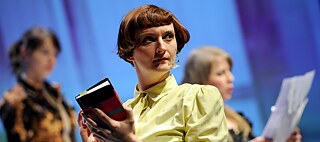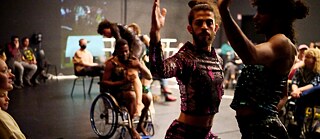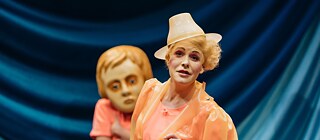Circus “Let’s Make Ourselves Visible!”
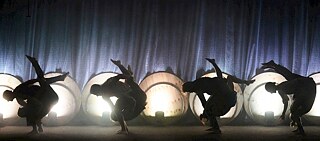
Contemporary circus has been achieving success on an international scale for years. The scene is becoming bigger and more visible in Germany too, even though in many places it’s still having to overcome stereotypes and fight for recognition as an art form. Here’s a review of the situation.
With a loud screak a chain is lowered down from the midnight blue roof canopy at LATIBUL, the theatre and circus school in Cologne. Dancer Mijin Kim uses a carabiner to attach a pommel horse weighing 110 kg, with a light brown body and four legs stiffly splayed outwards. As the gymnastics apparatus is hauled up on the chain, a routine at the intersection between contemporary circus and dance begins, in which different rules apply. The Overhead Project company uses gravitation, physical strength and the precision of dance to play around with our perception of space and time in Circular Vertigo. Everything revolves around the relationship between people, objects and space.
 The Overhead Project company plays around with our perception of space and time in their project “Circular Vertigo”.
| Photo © Alessandro De Matteis / Zeit für Zirkus
In the past ten years, more and more artists in Germany have been the focus of attention with works like this, providing thrills for an ever-growing audience. And that’s despite the fact that contemporary circus has travelled a bumpy road in this country: while in France they were experimenting with theatre and traditional circus back in the 1970s, these forays into cirque nouveau didn’t find a following in Germany until the 1980s and 1990s. The genre was gradually enhanced with narrative material, juggling and high-rope acrobatics were contrasted with dance and drama elements. Casual sequences of choreography, art and images were created as a result, which soon shifted into the realm of variety shows and caused cirque nouveau to disappear again after its emergence in Germany.
The Overhead Project company plays around with our perception of space and time in their project “Circular Vertigo”.
| Photo © Alessandro De Matteis / Zeit für Zirkus
In the past ten years, more and more artists in Germany have been the focus of attention with works like this, providing thrills for an ever-growing audience. And that’s despite the fact that contemporary circus has travelled a bumpy road in this country: while in France they were experimenting with theatre and traditional circus back in the 1970s, these forays into cirque nouveau didn’t find a following in Germany until the 1980s and 1990s. The genre was gradually enhanced with narrative material, juggling and high-rope acrobatics were contrasted with dance and drama elements. Casual sequences of choreography, art and images were created as a result, which soon shifted into the realm of variety shows and caused cirque nouveau to disappear again after its emergence in Germany.
When “Cirque Contemporain”, or contemporary circus – which crosses yet more boundaries with other art forms – came into being in France in the mid-1990s, performances were put on at the Tollwood Festival in Munich, or the Tollhaus Culture Centre in Karlsruhe. Nevertheless: the artists did not pique the interest of German audiences and so they sidestepped to France, Belgium and the Netherlands, as well as Greece, Romania and Spain.
Establishment As an Art Form
So when the Initiative Neuer Zirkus (New Circus Initiative) was founded in Cologne in 2011, it marked a turning point. The goal: to network performers across the nation and share knowledge. Although there were hardly any circus schools, something changed for the German cultural authorities and in terms of public perception. Just like dance and theatre, Contemporary Circus now had a voice of its own. From Hamburg and Mülheim an der Ruhr, Wiesbaden, Karlsruhe and Munich, as far as Jena, Leipzig or Berlin: on streets, marketplaces and theatre stages, in pedestrian shopping centres and circus tents – performers were adopting unusual perspectives, telling stories and creating new images. These shows involved a combination of floorwork with spectacular stage installations, and aerial acrobatics with elements of dance, performance and theatre – without losing focus on the artist’s body during this interaction with objects and apparatus in the space around it.
However if the tendency up to that point had been for circus artists to move away from Germany because of limited training opportunities, difficult funding conditions and a shortage of performance venues, that was also in the process of changing: small and large theatres and festivals were increasingly including contemporary circus in their programmes. These ranged from the Ruhrfestspiele Recklinghausen, E-Werk in Freiburg and Lofft The Theatre in Leipzig, to Haus der Berliner Festspiele and Potsdamer Tanztage. And in addition to traditional street theatre festivals such as La Strada in Bremen, Welttheater der Straße in Schwerte or Via Thea in Görlitz, new festivals were also being conjured out of thin air. For instance the Cologne Circus Dance Festival – which was established in 2019 by choreographer and circus artist Tim Behren and financed with funds from the TANZPAKT initiative – explicitly brings together contemporary circus and dance. This setting gives visibility to the forms, structures and discourses currently emerging in Germany.
When the Bundesverband Zeitgenössischer Zirkus e. V. (Federal Association for Contemporary Circus; BUZZ) developed out of the Initiative Neuer Zirkus in 2019 and took on its work as an umbrella organisation and lobby group, this became another driving force in establishing the field as an art form within the performing arts sector: an information and dialogue platform was set up for people involved in the scene, and the funding and mentoring programme Zirkus ON underwent further development. Artists set up their own festivals and production locations, initiated network meetings, and began to fight for recognition of their work at a political level. As a consequence the scene received public funding for the first time during the 2020 pandemic, and also received a significant infrastructure boost thanks to the NEUSTART culture grant from the German government.
A Description of Life As an Artist and Mother
The topical discourses about power, structure and gender inequality penetrated the scene, and in early 2022 the Initiative feministischer Circus (Feminist Circus Initiative; IfC) began to analyse existing power balances and develop proposals for more fairness on and behind the stage. While the self-understanding underwent transformation as a result, methods of working and aesthetics changed as well. In the same year, circus researcher and dramaturge Franziska Trapp described the situation thus: “While traditional circus celebrated the unusual abilities and powers of human beings, contemporary circus pieces are based on a self-understanding of being a critical and political art form.” Although even now circus is still frequently considered to be entertainment, the artists’ living and working reality is becoming more important in the same way as for dance, theatre or performance: questions concerning physical safety and financial security, gender equality in the workplace or diverse body images are all being dealt with on the stage.
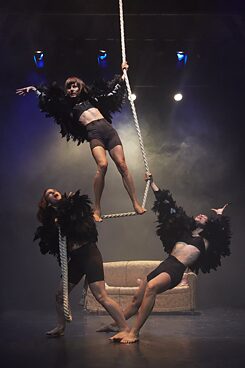 An artist and a mother – to what extent is work compatible with family life in the arts? The artists of the Still Hungry collective deal with this question in “Raven”.
| Photo: © Still Hungry/Chamäleon Berlin/Andy Phillipson
For instance I Was Told, a contemporary piece by Berlin-based juggler and spoken-word artist Kathrin Wagner, is all about sexism and her personal experiences as a circus and variety artist. About not needing a certain physique to be a circus performer, about tightrope artists not having to perform in a tutu or juggling being exclusive to men. And in Raven, Lena Ries, Romy Seibt and Anke van Engelshoven show audiences what it’s like to be an artist and mother. With their women’s collective from Berlin entitled Still Hungry, they call for more openness towards the diverse lifestyles of artists and campaign for family-friendly work models and against age discrimination. Whereas even recently a normative virtuosity was still requisite, this is now increasingly being challenged. Bodies are shown in all their diversity, while struggles and dangers are thematised.
An artist and a mother – to what extent is work compatible with family life in the arts? The artists of the Still Hungry collective deal with this question in “Raven”.
| Photo: © Still Hungry/Chamäleon Berlin/Andy Phillipson
For instance I Was Told, a contemporary piece by Berlin-based juggler and spoken-word artist Kathrin Wagner, is all about sexism and her personal experiences as a circus and variety artist. About not needing a certain physique to be a circus performer, about tightrope artists not having to perform in a tutu or juggling being exclusive to men. And in Raven, Lena Ries, Romy Seibt and Anke van Engelshoven show audiences what it’s like to be an artist and mother. With their women’s collective from Berlin entitled Still Hungry, they call for more openness towards the diverse lifestyles of artists and campaign for family-friendly work models and against age discrimination. Whereas even recently a normative virtuosity was still requisite, this is now increasingly being challenged. Bodies are shown in all their diversity, while struggles and dangers are thematised.
A startling feature here is the extent to which artists often still take for granted that they will be paid for performances, but not for research and their creative process. That’s something else that’s undergoing change thanks to programmes like Zirkus ON and NEUSTART Kultur, or residence opportunities at selected festivals and performance venues. But as with the training facilities, Germany’s still trailing a long way behind France and Belgium. In this regard, a continued and process-oriented funding approach cannot be valued highly enough for establishing and developing the scene.
Nevertheless, the tenacity and optimism that’s part of the circus DNA can be felt everywhere. Berlin artist and circus pedagogue Anja Gessenhardt said in an interview last year: “In contemporary circus we have the opportunity to break down stereotypes and bring about change by creating stories and turning dreams into reality. Let’s use this chance, let’s create enduring structures and make ourselves and our art visible!” Contemporary circus is on the move in Germany.
